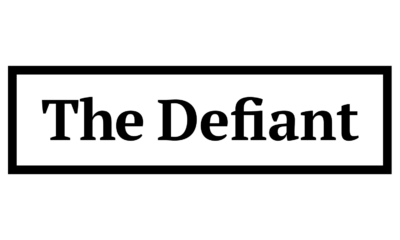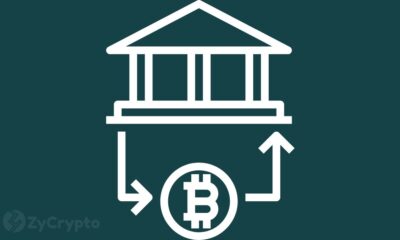DeFi
Fixed-Rate vs. Floating-Rate Loans in DeFi

Sponsored Content
By removing centralized gatekeepers, DeFi (decentralized finance) has created new opportunities for lending and borrowing. Today, within the burgeoning DeFi ecosystem, lending protocols are facilitating billions in crypto-backed loans. Intriguing, right? However, dealing with these open financial systems can be tricky, which may deter traditional users.
If you’re interested in DeFi lending, it’s important to understand the different loan structures available. Unlike traditional banks, which primarily offer fixed-rate and variable-rate loans, DeFi incorporates a slight variation of fixed-rate and variable-rate models that cater to a variety of needs. In this article, we’ll explore these two dominant lending approaches and an innovative platform, “Rock”, which can help you get crypto loans easily. But first, let’s take a detailed look at DeFi loans.
Introduction to DeFi (Decentralized Finance) Lending
At its core, DeFi lending facilitates secure and transparent loan transactions directly between borrowers and lenders, bypassing the need for intermediaries. Here’s a breakdown of how it works:
- Smart contracts: These self-executing programs on the blockchain automate the entire lending process. They ensure the secure transfer of funds, establish loan terms, and manage repayments, all without the intervention of a central authority.
- Peer-to-peer loans: Borrowers connect directly to lenders through DeFi protocols. Lenders deposit their crypto assets into lending pools, providing liquidity to borrowers. Borrowers can then access loans from these pools by providing collateral in the form of other cryptocurrencies.
- Transparency and immutability: All transactions within a DeFi lending protocol are recorded on a public blockchain. This ensures transparency and immutability, meaning transactions cannot be changed or deleted. And it promotes trust and accountability within the DeFi ecosystem.
DeFi lending is primarily dominated by two types of loans: variable-rate and fixed-rate. And each comes with its own set of benefits and risks, depending on market conditions and borrowing needs. Let’s take a closer look at each of these options now.
What are variable rate loans?
Floating-rate loans, also known as variable-rate loans, are the most common type of loan offered in DeFi. These loans come with interest rates that fluctuate in real-time based on market conditions and the supply and demand dynamics of the underlying lending protocols. When there is a high demand for loans and a limited supply of funds, interest rates tend to increase. Conversely, when there is an abundance of liquidity in the pool, interest rates can decrease.
Here are the two popular protocols for variable rate loans: Compound and Aave.
- Compound: It is one of the leading DeFi lending protocols that allows users to lend and borrow a variety of cryptocurrencies. Compound’s interest rates are determined algorithmically based on the supply and demand of each asset in the protocol. Users can earn interest on their deposits and borrow assets by providing collateral.
- Aave: Aave is another major DeFi lending protocol that offers a wide range of assets for lending and borrowing. Aave offers both stable and floating interest rate options for borrowers. The floating interest rate fluctuates based on market conditions, while the stable rate offers a more predictable borrowing cost over a certain period of time.
Common Use Cases for Variable Rate Loans
The variable nature of floating rate loans makes them particularly suitable for certain DeFi use cases:
- Leverage: Borrowers can use variable rate loans to leverage their cryptocurrency holdings and amplify their market exposure. Flexible rates allow them to maximize their borrowing power and potential returns.
- Yield agriculture: DeFi yield farmers often use floating-rate loans to fund their positions in liquidity mining protocols. The ability to frequently adjust loan amounts and repay them based on rate changes allows them to maximize their capital efficiency.
- Arbitration: Traders can use floating rate loans to capitalize on price spreads between lending platforms and DeFi exchanges, profiting from rate fluctuations.
Now let’s look at the advantages and disadvantages of variable rate loans.
Advantages of variable rate loans
- Potential for lower rates during periods of low demand
- No prepayment penalty, providing flexibility
- Often there is no fixed term, allowing borrowers to repay at any time.
Disadvantages of Variable Rate Loans
- Interest rates may increase unexpectedly, potentially increasing the cost of the loan
- It is difficult to plan long-term expenses due to fluctuations in rates
- Risk of liquidation in the event of a fall in the value of collateral or an increase in interest rates
Overall, floating rate loans have become popular in DeFi due to their dynamic nature and suitability for speculative strategies. However, floating rates also introduce some unpredictability, which can be problematic for long-term budgets or investment horizons extending beyond a few weeks/months. This is where fixed rate loans offer an alternative structure.
What are fixed rate loans?
Unlike variable rates, fixed-rate loans maintain a constant interest rate for the entire term of the loan agreement. This eliminates the uncertainty associated with fluctuating interest rates in DeFi lending pools. With a fixed rate, you know exactly how much your monthly payments will be, making budgeting and financial planning easier. This predictability makes them an attractive option for borrowers who prefer certainty in their repayment plans.
Notitional Finance is one of the most popular protocols for fixed rate loans:
- Notional finance: Notional is a DeFi protocol that specializes in fixed-rate lending and borrowing. It allows users to lock in a fixed interest rate for a set period of time, providing stability and predictability. Notional achieves this by creating tokenized debt instruments that represent fixed-rate loans.
Common Use Cases for Fixed Rate Loans
- Debt refinancing: Borrowers can use fixed-rate loans to refinance their existing debt at a more favorable rate. This helps them manage their debt more effectively and reduces the risk of rising interest rates.
- Major purchases: For large expenses like purchasing a property or financing a business, fixed-rate loans provide the stability needed to accurately plan long-term finances.
- Long term investments: Investors who wish to hold their positions for an extended period of time can benefit from the predictability of fixed rate loans. This is particularly useful in volatile markets where floating rates can fluctuate widely.
Now let’s look at the advantages and disadvantages of fixed rate loans.
Benefits of Fixed Rate Loans
- Predictable interest payments, making budgeting easier
- Protection against rising interest rates
- Suitable for long-term financial planning
Disadvantages of Fixed Rate Loans
- Potentially higher initial rates compared to variable rate loans
- Less flexibility, often with penalties for early repayment
- Losing potential savings if market rates fall
If you want to learn more about fixed rate loans, check out this comprehensive document guide.
While both floating-rate and fixed-rate loans have their pros and cons, navigating DeFi lending protocols and managing loans directly on-chain can still be challenging for many. To truly harness the benefits of decentralized finance for mainstream users, accessible interfaces are needed. That’s where platforms like Rocko come in. So, what is Roko and how can it help you with DeFi lending? Read on to find out.
Introducing Rocko: Your DeFi Borrowing Companion
Rocko positions itself as a user-friendly platform designed to simplify the DeFi borrowing experience, whether you choose a fixed or variable rate loan. Whether you are an experienced DeFi user or just getting started with DeFi, Rocko can be a valuable asset in unlocking the potential of DeFi lending.
Here’s how Rocko can supercharge your DeFi borrowing journey:
- Simplified loan setup process: Rocko’s intuitive interface simplifies the lending process, eliminating the complexities often associated with DeFi protocols.
- Loan Options Comparison Tool: Compare lending offers from different DeFi protocols, allowing you to choose the best deal based on your needs and preferences.
- Risk management tools: Rocko can provide you with information and tools to help you manage your loan effectively. This may include features such as collateral ratio tracking and potential liquidation warnings based on market fluctuations.
As you can see, the benefits of this platform are endless. With Rocko, users can enjoy the benefits of both variable and fixed-rate loans, allowing them to make informed financial decisions in the DeFi ecosystem. So, whether you’re looking to leverage assets for yield farming, refinance debt with a fixed-rate loan, or make a large purchase, Rocko is here to provide you with a streamlined solution that simplifies the crypto lending process and gives you peace of mind!
Conclusion
Choosing between a fixed-rate loan and a variable-rate loan depends on your personal financial goals and risk tolerance. If you value stability and predictability, fixed-rate loans can provide peace of mind with regular interest payments. However, if you’re comfortable with some volatility and potentially want a lower initial interest rate, variable-rate loans may be a more attractive option.
Whatever your choice, Rocko can be your valuable partner in helping you understand the world of DeFi borrowing. With its user-friendly interface, comprehensive loan comparison tools, and risk management features, Rocko allows you to make informed decisions for a secure and successful DeFi borrowing experience.
Would you like to know more about this innovative platform? Join Rocko’s Waiting List and unlock the potential of DeFi borrowing!
Disclaimer: The authors of sponsored articles are solely responsible for the opinions expressed or offers made. These opinions do not necessarily reflect the official position of Daily News from Hungaryand the editorial staff cannot be held responsible for their veracity.
DeFi
Haust Network Partners with Gateway to Connect to AggLayer

Dubai, United Arab Emirates, August 1, 2024, Chainwire
Consumer adoption of cryptocurrencies is a snowball that is accelerating by the day. More and more people around the world are clamoring for access to DeFi. However, the user interface and user experience of cryptocurrencies still lag behind their fundamental utility, and users lack the simple and secure access they need to truly on-chain products.
Haust Network is a network and suite of products focused on changing this paradigm and bringing DeFi to the masses. To achieve this goal, Haust Network has announced its far-reaching partnership with bridgeseasoned veterans in rapidly delivering revolutionary blockchain utilities for projects. The Gateway team empowers blockchain developers to build DAOs, NFT platforms, payment services, and more. They drive adoption of crypto primitives for individuals and institutions around the world by helping everyone build their on-chain presence.
Gateway specializes in connecting sovereign blockchains to the Aggregation Layer (AggLayer). The AggLayer is a single unified contract that powers the Ethereum bridge of many disparate blockchains, allowing them all to connect to a single unified liquidity pool. The AggLayer abstracts away the complexities of cross-chain DeFi, making tedious multi-chain transactions as easy for the end user as a single click. It’s all about creating access to DeFi, and with Polygon’s technology and the help of Gateways, Haust is doing just that.
As part of their partnership, Gateway will build an advanced zkEVM blockchain for Haust Network, leveraging its extensive experience to deploy ultra-fast sovereign applications with unmatched security, and enabling Haust Network to deliver its products to its audience.
The recently announced launch of the Haust Wallet is a Telegram mini-app that provides users with access to DeFi directly through the Telegram interface. Users who deposit funds into the wallet will have access to all standard send/receive services and generate an automatic yield on their funds. The yield is generated by Haust Network’s interconnected network of smart contracts, Haustoria, which provides automated and passive DeFi yielding.
As part of this partnership, the Haust Network development team will work closely with Gateway developers to launch Haust Network. Gateway is an implementation provider for Polygon CDK and zkEVM technology, which the Haust wallet will leverage to deliver advanced DeFi tools directly to the wallet users’ fingertips. Haust’s partnership with Gateway comes shortly after the announcement of a high-profile alliance with the Polygon community. Together, the three will work to build Haust Network and connect its products to the AggLayer.
About Haust Network
Haust Network is an application-based absolute liquidity network and will be built to be compatible with the Ethereum Virtual Machine (EVM). Haust aims to provide native yield to all users’ assets. In Telegram’s Haust Wallet, users can spend and collect their cryptocurrencies in one easy place, at the same time. Haust operates its network of self-balancing smart contracts that interact across multiple blockchains and then efficiently funnel what has been generated to Haust users.
About Gateway
bridge is a leading white-label blockchain provider that offers no-code protocol deployment. Users can launch custom blockchains in just ten minutes. They are an implementation provider for Polygon CDK and have already helped projects like Wirex, Gnosis Pay, and PalmNFT bring new utility to the crypto landscape.
About Polygon Labs
Polygon Laboratories Polygon Labs is a software development company building and developing a network of aggregated blockchains via the AggLayer, secured by Ethereum. As a public infrastructure, the AggLayer will aggregate the user bases and liquidity of any connected chain, and leverage Ethereum as the settlement layer. Polygon Labs has also contributed to the core development of several widely adopted scaling protocols and tools for launching blockchains, including Polygon PoS, Polygon zkEVM, and Polygon Miden, which is currently under development, as well as the Polygon CDK.
Contact
Lana Kovalski
haustnetwork@gmail.com
DeFi
Ethena downplays danger of letting traders use USDe to back risky bets – DL News

- Ethena and ByBit will allow derivatives traders to use USDe as collateral.
- There is a risk in letting traders use an asset partially backed by derivatives to place more bets.
Ethena has downplayed the dangers of a new feature, which will allow traders to put up its synthetic dollar USDe as collateral when trading derivatives, which are risky bets on the prices of crypto assets.
While allowing users to underwrite their trades with yield-bearing USDe is an attractive prospect, Ethena said there is potential risk in letting traders use an asset partially backed by derivatives to place even more derivatives bets.
“We have taken this risk into account and that is why Ethena operates across more than five different sites,” said Conor Ryder, head of research at Ethena Labs. DL News.
The move comes as competition in the stablecoin sector intensifies.
In recent weeks, PayPal grown up the amount of its stablecoin PYUSD in circulation 96%, while the MakerDAO cooperative plans a rebrandingaiming to increase the supply of its DAI stablecoin to 100 billion.
US dollar growth stagnates
It comes as Ethena has lost momentum after its blockbuster launch in December.
In early July, USDe reached a record level of 3.6 billion in circulation.
That figure has now fallen by 11% to around 3.2 billion.
Join the community to receive our latest stories and updates
New uses for USDe could boost demand for Ethena’s products.
This is where the new plan, announcement Tuesday with ByBit, one of its partner exchanges, is coming.
Ethena users create USDe by depositing Bitcoin or Ether into the protocol.
Ethena then covers these deposits with short positions – bearish bets – on the corresponding asset.
This creates a stable support for USDe, unaffected by price fluctuations in Bitcoin or Ether.
Mitigate risks
While using USDe as collateral for derivatives trading is proving popular, it is unclear what the effects will be if the cryptocurrency market experiences major fluctuations.
Using derivatives as collateral to place more bets has already had disastrous effects.
In June 2022, Lido’s liquid staking token stETH broke its peg to Ether following the fallout from the Terra collapse.
Many traders who used looping leverage to increase their stETH staking yields were liquidated, creating a cascade that caused the price of Ether to drop by more than 43%.
Ethena Labs founder Guy Young said: DL News His office and his partners have taken many precautions.
Ethena spreads bearish bets supporting the USDe across the five exchanges it partners with.
According to Ethena, 48% of short positions supporting USDe are on Binance, 23% on ByBit, 20% on OKX, 5% on Deribit, and 1% on Bitget. website.
In doing so, Ethena aims to minimize the impact of an unforeseen event on a stock market.
The same theory applies to the distribution of risks across different supporting assets.
Fifty percent of USDe is backed by Bitcoin, 30% by Ether, 11% by Ether liquid staking tokens, and 8% by Tether’s USDT stablecoin.
Previous reviews
Ethena has already been criticised regarding the risks associated with USDe.
Some have compared USDe to TerraUSD, an undercollateralized stablecoin that collapsed in 2022.
“It’s not a good design for long-term stability,” said Austin Campbell, an assistant professor at Columbia Business School. said as the USDe launch approaches.
Young replied to critics, saying the industry needs to be more diligent and careful when “marketing products to users who might not understand them as well as we do.”
Ethena has since added a disclaimer on its website stating that USDe is not the same as a fiat stablecoin like USDC or USDT.
“This means that the risks involved are inherently different,” the project says on its website.
Tim Craig is DL News DeFi correspondent based in Edinburgh. Feel free to share your tips with us at tim@dlnews.com.
DeFi
Cryptocurrency and defi firms lost $266 million to hackers in July

In July 2024, the cryptocurrency industry suffered a series of devastating attacks, resulting in losses amounting to approximately $266 million.
Blockchain Research Firm Peck Shield revealed in an X post On August 1, attacks on decentralized protocols in July reached $266 million, a 51% increase from $176 million reported in June.
The most significant breach last month involved WazirX, one of India’s largest cryptocurrency exchanges, which lost $230 million in what appears to be a highly sophisticated attack by North Korean hackers. The attack was a major blow to the stock market, leading to a break in withdrawals. Subsequently, WazirX launched a program in order to recover the funds.
Another notable incident involved Compound Finance, a decentralized lending protocol, which suffered a governance attack by a group known as the “Golden Boys,” who passed a proposal who allocated 499,000 COMP tokens – valued at $24 million – to a vault under their control.
The cross-chain liquidity aggregation protocol LI.FI also fell victim On July 16, a hack resulted in losses of $9.73 million. Additionally, Bittensor, a decentralized machine learning network, was one of the first protocols to suffer an exploit last month, loming $8 million on July 3 due to an attack targeting its staking mechanism.
Meanwhile, Rho Markets, a lending protocol, suffered a $7.6 million breach. However, in an interesting twist, the exploiters research to return the stolen funds, claiming the incident was not a hack.
July 31, reports The Terra blockchain protocol was also hacked, resulting in a loss of $6.8 million across multiple cryptocurrencies. As crypto.news reported, the attack exploited a reentrancy vulnerability that had been identified a few months ago.
Dough Finance, a liquidity protocol, lost $1.8 million in Ethereum (ETH) and USD Coin (USDC) to a flash loan attack on July 12. Similarly, Minterest, a lending and borrowing protocol, saw a loss of $1.4 million due to exchange rate manipulation in one of its markets.
Decentralized staking platform MonoSwap also reported a loss of $1.3 million following an attack that allowed the perpetrators to withdraw the liquidity staked on the protocol. Finally, Delta Prime, another decentralized finance platform, suffered a $1 million breach, although $900,000 of the stolen funds was later recovered.
DeFi
The Rise of Bitcoin DeFi: Then and Now

The convergence of Bitcoin’s robust security and Layer 2 scaling solutions has catalyzed the emergence of a vibrant DeFi ecosystem.
By expanding Bitcoin’s utility beyond simple peer-to-peer payments, these advancements have opened up a new frontier of financial possibilities, allowing users to participate in decentralized lending, trading, and other complex smart contract operations on Bitcoin.
Read on to learn about the rise of Bitcoin-based decentralized finance and how the space has expanded to accommodate a new generation of native assets and features.
Note: If you want to learn candlesticks and chart trading from scratch, this is the best book available on Amazon! Get the book now!
What is DeFi?
Decentralized finance (DeFi) represents a paradigm shift in financial services, offering internet-based financial products such as trading, lending, and borrowing through the use of decentralized public blockchains.
By implementing blockchains, smart contracts, and digital assets, DeFi protocols provide financial services through a decentralized ecosystem, where participants do not have to deal with intermediaries when transacting.
What is Bitcoin DeFi?
The inherent limitations of the Bitcoin mainchain in supporting the intricacies of decentralized finance have created the need to develop smart contract-based Layer 2 solutions.
Additionally, the advent of the Ordinals protocol in 2023, which facilitated the emergence of fungible token standards such as BRC-20 and Runes, catalyzed the growth of DeFi on the Bitcoin blockchain.
This expansion in protocol diversity has broadened the applications of the world’s leading cryptocurrency network beyond the core base-layer use cases around value preservation and transactional capabilities.
Therefore, Bitcoin DeFi has become a nascent sector within the digital asset market, after previously being a missing essential part of the Bitcoin ecosystem.
Bitcoin DeFi in its early days
Integrating decentralized finance (DeFi) concepts into the Bitcoin ecosystem has been a journey of innovation and perseverance. Early attempts to bridge the gap between Bitcoin’s fundamental simplicity and DeFi’s complexities have spawned pioneering projects that, while laying essential foundations, have also encountered significant obstacles.
Colored coins
Colored coins represented an early foray into tokenizing real-world assets on the Bitcoin blockchain. By leveraging the existing network to track ownership of assets ranging from stocks to real estate, this approach highlighted Bitcoin’s potential as a platform beyond digital currency. However, scalability and practical implementation challenges have limited its widespread adoption.
Counterpart
Building on the colored coins, Counterparty has become a platform for creating and trading digital assets, including non-fungible tokens (NFTs), on Bitcoin.
The introduction of popular projects like Rare Pepe NFTs has demonstrated the growing appeal of digital collectibles. However, constraints around user experience and network efficiency have hampered its full potential.
These early experiments, while not fully realizing their ambitions, served as valuable stepping stones, informing Bitcoin DeFi’s subsequent developments. Their challenges highlighted the need for more sophisticated infrastructure and protocols to harness the full potential of decentralized finance on the Bitcoin network.
Bitcoin DeFi Today
Today, building DeFi applications on Bitcoin is primarily done in the realm of Layer 2 (L2) networks. This architectural choice is motivated by the limitations of Bitcoin’s base layer in supporting complex programmable smart contracts.
Bitcoin’s original design prioritized security and decentralization over programmability, making it difficult to develop sophisticated DeFi protocols directly on its blockchain. However, the recent emergence of protocols like Ordinals, BRC-20, and Runes, while not DeFi in their own right, has sparked possibilities for future DeFi-like applications on the main chain.
In contrast, L2 solutions offer a scalable and programmable environment built on Bitcoin, enabling the creation of various DeFi products.
By expanding Bitcoin’s capabilities without compromising its core principles, L2s have become the preferred platform for developers looking to build DeFi applications that encompass trading, lending, staking, and more.
Leading L2 networks such as Lightning Network, Rootstock, Stacks, and Build on Bitcoin provide the infrastructure for these efforts. Some of these L2s have even introduced their own native tokens to the network, further expanding Bitcoin’s DeFi ecosystem.
Essentially, while Bitcoin’s core layer presents challenges for DeFi development, its security and decentralization have provided a foundational layer for the innovative L2 landscape to thrive.
Bitcoin Layer 2 offers a promising path to building a robust and thriving Bitcoin-based DeFi ecosystem that offers trading, staking, lending, and borrowing. All you need is a DeFi Wallet like Xverse to access the new world of decentralized financial services secured by Bitcoin.
Conclusion
The integration of DeFi principles into the Bitcoin ecosystem, primarily facilitated by Layer 2 solutions, marks a significant evolution in the digital asset landscape.
Building on the foundational work of pioneers like Colored Coins and Counterparty, the industry has evolved into more sophisticated platforms like Rootstock, Stacks, and Build on Bitcoin to create a thriving Bitcoin-powered DeFi ecosystem.
Advertisement
-

 News1 year ago
News1 year agoBitcoin soars above $63,000 as money flows into new US investment products
-

 DeFi1 year ago
DeFi1 year agoEthena downplays danger of letting traders use USDe to back risky bets – DL News
-

 News1 year ago
News1 year agoFRA Strengthens Cryptocurrency Practice with New Director Thomas Hyun
-

 DeFi1 year ago
DeFi1 year agoZodialtd.com to revolutionize derivatives trading with WEB3 technology
-

 Markets1 year ago
Markets1 year agoBitcoin Fails to Recover from Dovish FOMC Meeting: Why?
-

 DeFi1 year ago
DeFi1 year ago👀 Lido prepares its response to the recovery boom
-

 Markets1 year ago
Markets1 year agoWhale Investments in Bitcoin Reached $100 Billion in 2024, Fueling Crazy Investor Optimism ⋆ ZyCrypto
-

 Markets1 year ago
Markets1 year agoWhy Bitcoin’s price of $100,000 could be closer than ever ⋆ ZyCrypto
-

 DeFi1 year ago
DeFi1 year agoPancakeSwap integrates Zyfi for transparent, gas-free DeFi
-

 Markets1 year ago
Markets1 year agoWhales are targeting these altcoins to make major gains during the bull market 🐋💸
-

 DeFi1 year ago
DeFi1 year ago🏴☠️ Pump.Fun operated by Insider Exploit
-

 News1 year ago
News1 year agoHow to make $1 million with crypto in just 1 year 💸📈







